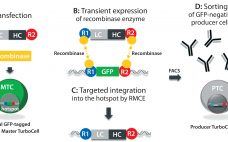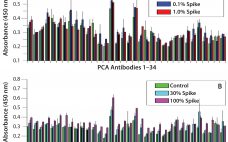What we’ve come to know as the annual BioProcess International Conference has become a lot more than that. BPI magazine and conference, previously separate but collaborative business units, now live within KNect365: Informa’s relatively new business unit bringing together common interests of several new and existing businesses in the company’s “knowledge and networking” portfolio. It includes products and events from other groups that have joined Informa over the past decade or so. Some of those acquisitions may be familiar to…
November 2017
November Spotlight
Crowdsourcing Cancer Research and Biomanufacturing In June, BioMed X launched two new global calls for application together with Merck KGaA for RNA splicing in cancer and for engineering of high-performance production cell lines. Talented young scientists from top universities and research institutions were invited to submit innovative project proposals and apply for a research fellowship at the BioMed X Innovation Center in Heidelberg, Germany. BioMed X was founded in 2013 in collaboration with Merck, its first pharmaceutical partner. Since then,…
Data Analysis and Visualization to Improve Biopharmaceutical Operations Part 1: What Are You Trying To Measure?
This begins a five-article series of “how-to” guides for tackling the most common obstacles in assessing, measuring, analyzing, and improving the performance of global biopharmaceutical manufacturing operations. Each installment covers a component of proper collection, analysis, and use of data for the best possible performance outcomes. When taken as a whole, the series should provide imperative best practices for handling business-performance data. First, consider what you want to know about your bioprocesses. How can you more appropriately measure those data…
Antibody–Drug Conjugates: Fast-Track Development from Gene to Product
In the fight against cancer, antibody–drug conjugates (ADCs) represent an increasingly important therapeutic approach. These biopharmaceuticals are designed to maximize the therapeutic index of cytotoxic small-molecule drugs through their selective delivery to tumor cells while leaving normal, healthy cells untouched. Structurally, an ADC is a monoclonal antibody (MAb) conjugated by a chemical linker to a potent cytotoxic drug. Conceptually, the MAb serves as the delivery component, targeting a specific tumor antigen that ideally is not expressed (or is expressed at…
Antibody Higher Order Structure Stability: Polymorphism Revealed By Protein Conformational Array
For protein therapeutics and other biologics, the importance of the molecule’s structure to its efficacy and safety is well established (1–5). In particular, their tertiary and quaternary structures play very important roles in product quality and have been monitored extensively in comparability studies (6–12). However, because of both the large molecular size and rotational property of amino acid α carbons, a protein can assume an enormous number of different conformations (13). For antibody-based biologics such as monoclonal antibodies (MAbs), fusion…
µPAC™ Microchip Chromatography: Better By Design
The boundaries of technology can be pushed significantly when insights from different fields reinforce each other. Based on in silico simulations demonstrating the importance of order on the efficiency of chromatographic separations, PharmaFluidics has combined expertise from the analytical chromatography and semiconductor chip manufacturing industries to create a new type of nanoscale liquid chromatography (LC) column. Conventional LC columns contain randomly packed beads as a stationary phase. By contrast, PharmaFluidics uses a lithographic etching process to create a perfectly ordered…
A Stirred, Single-Use, Small-Scale Process Development System: Evaluation for Microbial Cultivation
Mammalian and microbial protein production platforms have been used for over 30 years to produce a number of successful biologic drugs, including monoclonal antibodies (MAbs), recombinant proteins, and therapeutic enzymes (1). Most biologics are produced by mammalian cell lines, with Chinese hamster ovary (CHO) cells being the most widely used. However, microbial cells also are used to express recombinant therapeutic proteins, and almost 30% of currently approved biologics are produced by Escherichia coli bacteria (2). With worldwide biologics sales >56…
Better Solutions Needed As Cancer Drug Costs Escalate
The out-of-pocket price of many life-saving cancer medications continues to rise while insurance companies continue to raise deductibles and copays. Patients are paying more for their prescriptions than ever before, and they need solutions that offer cost-effective treatment. The Oncological Problem Cancer is the second leading cause of death in the United States. More often than ever before, patients obtaining potentially life-saving cancer drugs face a severe financial burden (1). Newer cancer medications can cost patients over US$100,000 each year,…
Ask the Expert: Purification of Antibody Fragments Using Amsphere A3 Protein A Resin
In an “Ask the Expert” webinar on 13 September 2017, Gerald Platteau of JSR Life Sciences described the use of Amsphere A3 resin to purify antibody fragments. He explained the molecular binding mechanism for VHH singledomain antibodies and compared dynamic binding capacity (DBC) data with those of other affinity resins. Platteau’s Presentation For full-size monoclonal antibodies (MAbs), the standard capture step is based on protein A. Its binding to the Fc region has been well described as taking place at…
Ask the Expert: Single-Use Bag Permeability Testing in Cryopreservation Conditions
In BPI’s “Ask the Expert” webcast on 4 October 2017, Mike Johnson (market development manager at Entegris Life Sciences) discussed single-use bags and gas permeation. Johnson’s Presentation Permeation rates are a function of fluid properties, the type of material being penetrated, and application temperature. Standardized test methods used to determine permeability characteristics include ASTM D1434 and ASTM D3985. A fixture in Entegris’s test apparatus holds a sample plaque that is flanked upstream by high-pressure gas and downstream by a sensor…






